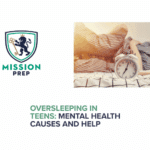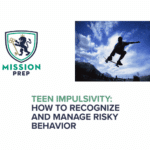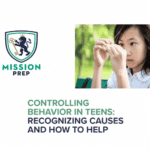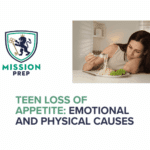Heart Palpitations in Teens: Anxiety-Related Symptoms and Help

Anxiety disorders and panic attacks tend to have physical symptoms that mimic serious health concerns – heart palpitations in particular.
When a teen experiences heart palpitations as a result of an anxiety disorder, they may not understand the root cause of this frightening symptom, often leading to emergency medical attention. While a racing heart and other cardiovascular symptoms of stress are understandably scary, the good news is that these issues are treatable.
By seeking both medical and mental health treatment, teens and their families can feel safer when dealing with physical symptoms of anxiety. Moreover, once a potential underlying medical cause is ruled out, a mental health professional can advise families on the best route of treatment for their needs.
This article can also work as a helpful guide to understanding heart palpitations in teens, as it explores:
- What heart palpitations in adolescents are
- Why some teens experience heart palpitations
- Treatment options for teen physical symptoms of stress
- Coping strategies for stress and heart palpitations in adolescents
- How parents can provide support for anxious teens
- Where to find professional support
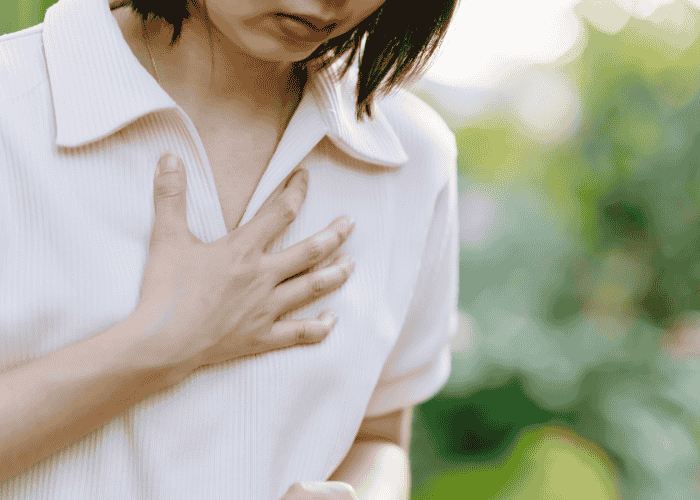
What Are Heart Palpitations in Adolescents?
Despite how heart palpitations are a common symptom of anxiety, it’s always important to get them medically assessed. Research shows that, in general, 43% of patients referred to a cardiac clinic for heart palpitations had an actual cardiac problem. Yet, psychiatric health issues accounted for 31% of the cases. While such studies tend to predominantly involve adults, these statistics demonstrate that it’s important to rule physical health issues out. After this point, mental health treatment is often a suitable approach for managing heart palpitations.1
A recent study, which looked at the relationship between heart palpitations and mental health, reported that patients commonly experienced issues such as:
Depression- Anxiety
- Somatoform disorder
- Other mental health concerns
These disorders accounted for 84% of people who had presented with heart palpitations related to mental health issues.1 However, in teens, anxiety and stress are likely to be the most common contributors to a racing heart. Therefore, recognizing stress-related heart issues is often the first step in getting them under control.
Recognizing Anxiety-Related Palpitations in Teens
As mentioned, seeking the care of a medical professional is important when teens first present with heart palpitations. Oftentimes, a cardiologist will recommend some sort of event recorder, like a 24-hour ECG, to assess the teen’s cardiac function. If they rule out cardiac issues after this testing, it’s time to consider other causes – such as anxiety.
Heart palpitations are one of many potential anxiety symptoms in adolescents. One of the first signs a teen might notice is chest pain. However, you might initially struggle to clearly tie this symptom to a stressful or anxiety-provoking event, making it difficult to recognize that this is a mental health concern.2
However, anxiety disorders, such as panic attacks, are often accompanied by symptoms other than heart palpitations. Therefore, looking for additional signs, such as a feeling of suffocation, sweating, dizziness, and racing thoughts, can help with recognizing anxiety-related palpitations in teens.3
Why Do Some Teens Have Heart Palpitations?
It’s important to note that not all teens with anxiety or mental health issues will experience heart palpitations in their lifetime. There are some factors that predispose adolescents to this symptom, such as exposure to traumatic events or situations, genetic influences, and personality traits.3
Specifically, traumatic events in the home or at school may be significant risk factors for physical manifestations of anxiety in teens. Plus, experiencing a natural disaster such as an earthquake or a global pandemic (like the recent spread of COVID-19) can lead to an increase in stress-related heart issues.3
There is also increasing evidence to support how anxiety and other mental illnesses are heritable, meaning that they can be passed on through the family line. In fact, there are specific genes that have been studied, leading researchers to measure what is known as the “heritability index” of anxiety. In other words, they can assess how much this genetic component could contribute to anxiety-based behavior.3
Finally, a teen’s temperament or natural affect can play a role in how they experience anxiety and stress. Notably, social withdrawal and increased displays of stress in everyday life. This “negative affect” is closely related to anxiety and depression in teens. One sign of this type of temperament includes feeling like things are out of control. This is because, when we perceive that we have little to no control over the situations around us, feelings of worry and dread can creep up.3
Mental Health Treatment for Teens With Heart Palpitations
Adolescent mental health awareness is a major focus in today’s society. This is because, by spreading awareness, we can lower the barriers to treatment – making therapy more accessible to those who need it. Therefore, if your teen is suffering from heart palpitations that are linked to an underlying mental health issue, you can feel confident that there are plenty of treatment options available.
However, the type of therapy most suited to your child’s needs may come down to their specific symptoms and circumstances. The following are some evidence-based approaches for managing anxiety-related heart palpitations in adolescents.
Therapy for Anxiety Symptoms
Cognitive behavior therapy (CBT) is one of the main therapeutic methods targeting early intervention for anxiety in teens.4 Some of the components of CBT that make it the first line of treatment for anxiety include psychoeducation in individual sessions. This increased awareness can help improve symptoms through planned exposures and cognitive restructuring to promote more positive thinking.5
Another appealing aspect of CBT as therapy for anxiety symptoms is that there is plenty of flexibility in the format. For instance, teens can work one-on-one with a psychotherapist, participate in peer groups, work with their family, and even get treatment via telehealth.5 In other words, treatment can be tailored to the teen’s needs, learning style, and preferences to promote better outcomes.
Relaxation Techniques for Teens
When managing panic attacks, practicing relaxation techniques for teens can be crucial. There are a variety of research-based techniques that can easily be implemented in an outpatient setting. These include:
Progressive Muscle Relaxation:
One relaxation technique that has a lot of research to support its efficacy is progressive muscle relaxation.6 Progressive muscle relaxation is tied to physical effects that combat anxiety, such as regulating blood pressure, stabilizing pulse rate, and lowering stress hormone levels (cortisol).
Abbreviated Progressive Muscle Relaxation (APMR):
A recent study identified that even an abbreviated progressive muscle relaxation (APMR) can effectively reduce anxiety in adolescents.7 The technique involves tensing and relaxing core muscle groups in the body (hands, neck, arms, shoulders, legs, and so on). By focusing on the physical sensation of the release of muscle tension, a teen can learn where they feel stress in their body. This can lead to increased comfort in stressful situations.
Diaphragmatic Breathing:
Other stress management programs for teens include a related relaxation technique called “diaphragmatic breathing.” During this technique, teens are instructed to place one hand on the abdominal area and the other on their chest to feel the breath moving through the nose and diaphragm. By focusing on and controlling the rate and pattern of breath, diaphragmatic breathing can reduce physiological symptoms of anxiety in teens.8
Imagery Training:
Imagery training is another method of treating anxiety in teens. While there are many approaches to guided imagery, a key recommendation is to have a structured script that can be read aloud to teens so they can follow along. During sessions, teens are asked to visualize positive, comforting situations, such as succeeding in a task they were worried about or engaging in a behavior that helps cope with negative emotions.9
There are, of course, other relaxation techniques designed to address anxiety in teens. However, the ones listed are a good place to start. They can be especially useful when bridging the gap before receiving therapy or even as a complement to sessions. Ultimately, they can help a teen with physical anxiety symptoms feel more in control of their body and mind.
Coping Strategies for Heart Palpitations in Adolescents
For example, grounding exercises, deep breathing, and mindfulness strategies can be brought into play even when the mind and body feel distracted. One helpful grounding technique is to keep a textured object at hand. Whenever distress starts to kick in, stroking this object can help bring the mind back to the present moment.
Additionally, a skill promoted in DBT distress tolerance is TIP. This acronym signals teens to use temperature, intense exercise, paced breathing, and progressive muscle relaxation to tolerate high levels of distress and anxiety.10,11
Parental Support for Anxious Teens
Further, engaging in family therapy sessions to monitor a child’s progress may also be important for long-term success. Talking about which techniques are working and which aren’t can help direct parents when managing their teens’ stress-related heart issues, like palpitations, at home.

Mission Prep: Helping Teens Who Are Struggling
At Mission Prep, we pride ourselves on providing effective treatment for teens with anxiety. If you’ve noticed that your teen is experiencing stress-related heart issues and other cardiovascular symptoms of anxiety, our compassionate and licensed team can help.
Whether you’re looking for outpatient treatment or a more intensive residential facility, we can help you navigate your options and find the right teen anxiety treatment for your child.
Ready to take the next step in finding support for your teen’s mental health struggles? Contact Mission Prep today to speak with a qualified mental health professional who can answer questions and offer advice and encouragement.
References
- Alijaniha, F., Noorbala, A., Afsharypuor, S., Naseri, M., Fallahi, F., Mosaddegh, M., Zadeh, S. F., & Sadrai, S. (2015). Relationship between palpitation and mental health. Iranian Red Crescent Medical Journal, 18(3). https://doi.org/10.5812/ircmj.22615
- Radvar, M., Zolfigol, A., Kiani, A., Abbasi, E., & Sadeghpour, Y. (2019). Frequency of anxiety disorders in children and adolescents as non-cardiac chest pain. Journal of Preventive Epidemiology, 4(2), e22-e22.
- Manoliu, I. (2024). SOCIAL ANXIETY IN ADOLESCENTS. International Journal of Communication Research, 14(2), 150-165.
- Abutalebi Ahmadi, T. (2013). Stress and anxiety in adolescence. European Online Journal of Natural and Social Sciences, 2(3), pp-359.
- Patriarca, G., Pettit, J., & Silverman, W. (2022). Implementing Cognitive-Behavioral Therapy in Children and Adolescents with Anxiety Disorders. Clinical Psychology and Special Education, 11(2), 108–122. https://doi.org/10.17759/cpse.2022110207
- Cahyanto, E. B., & Suratih, K. (2021). Effect of progressive muscle relaxation on anxiety. PLACENTUM Jurnal Ilmiah Kesehatan Dan Aplikasinya, 9(3), 38. https://doi.org/10.20961/placentum.v9i3.54783
- Tsai, M., Cheng, T., Yang, Y., & Wang, C. (2021). A School-Based Progressive Muscle Relaxation Program for Female Adolescents: Development and the effectiveness on Physiological and Psychological evidence. Healthcare, 9(10), 1319. https://doi.org/10.3390/healthcare9101319
- Tsakona, P., Kitsatis, I., Apostolou, T., Papadopoulou, O., & Hristara-Papadopoulou, A. (2025). The effect of diaphragmatic breathing as a complementary therapeutic strategy in stress of children and teenagers 6–18 years old. Children, 12(1), 59. https://doi.org/10.3390/children12010059
- Skeens, L. M. (2017). Guided Imagery: a technique to benefit youth at risk. National Youth-At-Risk Journal, 2(2). https://doi.org/10.20429/nyarj.2017.020207
- Salimi, S., & Gheirati, S. (2024). The effectiveness of dialectical behavior therapy on self-control and anxiety tolerance in adolescents with mood disorders. Journal of School Psychology and Institutions, 12(4), 93-108.
- Linehan, M. M., & Wilks, C. R. (2015). The course and Evolution of Dialectical Behavior Therapy. American Journal of Psychotherapy, 69(2), 97–110. https://doi.org/10.1176/appi.psychotherapy.2015.69.2.97

